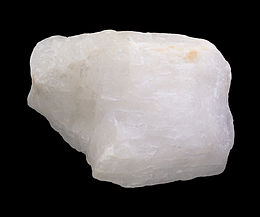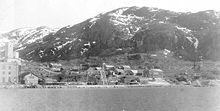
Cryolite
| Cryolite | |
|---|---|
 Cryolite from Ivigtut Greenland
| |
| General | |
| Category | Halide mineral |
|
Formula (repeating unit) |
Na3AlF6 |
| IMA symbol | Crl |
| Strunz classification | 3.CB.15 |
| Dana classification | 11.6.1.1 |
| Crystal system | Monoclinic |
| Crystal class | Prismatic (2/m) (same H-M symbol) |
| Space group | P21/n |
| Unit cell | a = 7.7564(3) Å, b = 5.5959(2) Å, c = 5.4024(2) Å; β = 90.18°; Z = 2 |
| Identification | |
| Formula mass | 209.9 g mol−1 |
| Color | Colorless to white, also brownish, reddish and rarely black |
| Crystal habit | Usually massive, coarsely granular. The rare crystals are equant and pseudocubic |
| Twinning | Very common, often repeated or polysynthetic with simultaneous occurrence of several twin laws |
| Cleavage | None observed |
| Fracture | Uneven |
| Tenacity | Brittle |
| Mohs scale hardness | 2.5 to 3 |
| Luster | Vitreous to greasy, pearly on {001} |
| Streak | White |
| Diaphaneity | Transparent to translucent |
| Specific gravity | 2.95 to 3.0. |
| Optical properties | Biaxial (+) |
| Refractive index | nα = 1.3385–1.339, nβ = 1.3389–1.339, nγ = 1.3396–1.34 |
| Birefringence | δ = 0.001 |
| 2V angle | 43° |
| Dispersion | r < v |
| Melting point | 1012 °C |
| Solubility | Soluble in AlCl3 solution, soluble in H2SO4 with the evolution of HF, which is poisonous. Insoluble in water. |
| Other characteristics | Weakly thermoluminescent. Small clear fragments become nearly invisible when placed in water, since its refractive index is close to that of water. May fluoresce intense yellow under SWUV, with yellow phosphorescence, and pale yellow phosphorescence under LWUV. Not radioactive. |
| References | |
Cryolite (Na3AlF6, sodium hexafluoroaluminate) is an uncommon mineral identified with the once-large deposit at Ivittuut on the west coast of Greenland, mined commercially until 1987.
History
Cryolite was first described in 1798 by Danish veterinarian and physician Peder Christian Abildgaard (1740–1801); it was obtained from a deposit of it in Ivigtut (old spelling) and nearby Arsuk Fjord, Southwest Greenland. The name is derived from the Greek language words κρύος (cryos) = frost, and λίθος (lithos) = stone. The Pennsylvania Salt Manufacturing Company used large amounts of cryolite to make caustic soda and fluorine compounds, including hydrofluoric acid at its Natrona, Pennsylvania, works, and at its integrated chemical plant in Cornwells Heights, Pennsylvania, during the 19th and 20th centuries.
It was historically used as an ore of aluminium and later in the electrolytic processing of the aluminium-rich oxide ore bauxite (itself a combination of aluminium oxide minerals such as gibbsite, boehmite and diaspore). The difficulty of separating aluminium from oxygen in the oxide ores was overcome by the use of cryolite as a flux to dissolve the oxide mineral(s). Pure cryolite itself melts at 1012 °C (1285 K), and it can dissolve the aluminium oxides sufficiently well to allow easy extraction of the aluminium by electrolysis. Substantial energy is still needed for both heating the materials and the electrolysis, but it is much more energy-efficient than melting the oxides themselves. As natural cryolite is now too rare to be used for this purpose, synthetic sodium aluminium fluoride is produced from the common mineral fluorite.
In 1940 before World War II, the United States became involved with protecting the world's largest cryolite mine in Ivittuut, Greenland from falling into the Nazi Germany's control.
Source locations
Besides Ivittuut, on the west coast of Greenland where cryolite was once found in commercial quantities, small deposits of cryolite have also been reported in some areas of Spain, at the foot of Pikes Peak in Colorado, Francon Quarry near Montreal in Quebec, Canada and also in Miask, Russia.
Uses
Molten cryolite is used as a solvent for aluminium oxide (Al2O3) in the Hall–Héroult process, used in the refining of aluminium. It decreases the melting point of aluminium oxide from 2000 to 2500 °C to 900–1000 °C, and increases its conductivity thus making the extraction of aluminium more economical.
Cryolite is used as an insecticide and a pesticide. It is also used to give fireworks a yellow color.
Physical properties

Cryolite occurs as glassy, colorless, white-reddish to gray-black prismatic monoclinic crystals. It has a Mohs hardness of 2.5 to 3 and a specific gravity of about 2.95 to 3.0. It is translucent to transparent with a very low refractive index of about 1.34, which is very close to that of water; thus if immersed in water, cryolite becomes essentially invisible.
- Phase transitions and volumetric properties of cryolite, Na3AlF6: Differential thermal analysis to 100 MPa; American Mineralogist; January 2006; v. 91; no. 1; p. 97-103; doi:10.2138/am.2006.1772
| Authority control: National |
|---|
